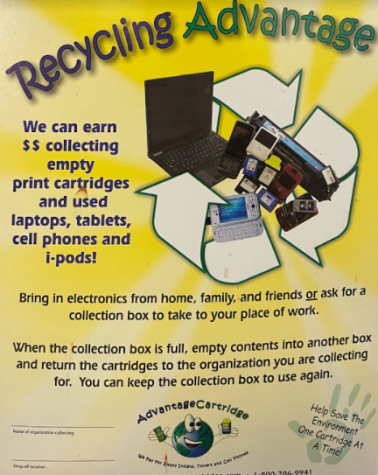Mr. Walker promotes recycling of electronics
It is common knowledge that Carroll often recycles paper, cardboard and glass products, but you may not have known that there is also a way to recycle your broken electronics.
According to Integrated Chemistry-Physics and AP Environmental Science teacher Jim Walker, who is also the department chair for the Sciences branch, “The school has paper and aluminum and basic recycling but as far as electronic waste… I just have this in my classroom so if students have broken phones they can put them in there.”
As reported by dosomething.org, electronic waste makes up only 2% of America’s landfill trash, but it equals 70% of worldwide toxic waste. Additionally, 20 to 50 million tons of e-waste are thrown away every year. Only 12.5% of that e-waste is recycled.
Walker has been responsible for technology recycling for a couple of years now, but he has not collected many electronics.
“I have it out there, and students put very few items in there. People just really don’t recycle e-waste, it’s easier to throw it away or it ends up sitting in crevices in our house. We end up storing all this stuff because it seems too valuable to actually throw it away,” he said. “I mention it every year but most people don’t bring anything, which is fine.”
The company that has been responsible for the program is Recycling Advantage who has been running the project since 1994.
The process is simple; once the box is completely filled with electronics it is able to be sent back to the company.
“That company will give a few dollars per item that we send them, like printer cartridges or phones that don’t work anymore, broken tablets… the dollar value is set based on the item that they receive because they break it down and scrap it and then they sell off the parts that they can sell,” said Walker.
The money sent back is then utilized for more environmentally-friendly activities that aim to improve the Carroll property. Students may have noticed the neat rows of young tree saplings that line the student and North teacher lots.
According to Walker, “Whatever money they would send would I would make the check out to the environmental club or class account and then we take that money in the account and we buy a big tree to plant every year around campus, and every year we have an AP Environmental Science tree planting. It just makes the campus look much nicer.”

If students want to help fund the environmental department’s tree planting program and aim to reduce their personal e-waste output, the electronics recycling program is the way to go.
Flip phones, smartphones, tablets, laptops, empty or unused ink cartridges, or other electronic devices that are broken or are no longer used can be dropped into the bright yellow box at the back of room 110 at any time. Happy recycling!

Peyton Holsworth is a junior at Carroll. This is her first year writing for The Charger Online. She is looking forward to working with the newspaper staff...





